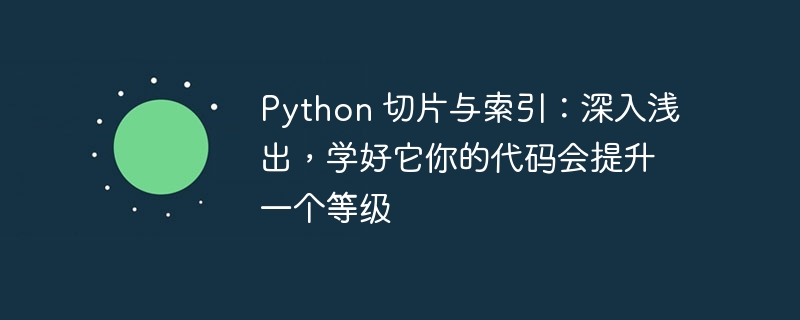Home >Backend Development >Python Tutorial >Python slicing and indexing: explain it in simple terms, learn it well and your code will improve to a new level
Python slicing and indexing: explain it in simple terms, learn it well and your code will improve to a new level
- WBOYforward
- 2024-02-19 22:33:21675browse

python Slicing and Indexing are special operations for sequence types, including lists, tuples and strings . Slicing is used to extract a portion of an existing sequence, while indexing is used to access a single element in a sequence. By combining these two features, you can easily manipulate data and perform various tasks.
slice
Slicing uses square brackets [] to indicate the part to be extracted. You can specify one or more values within square brackets to specify the range to extract. The syntax is: [start:stop:step].
- start: Specify the starting position of the slice. If omitted, starts from the beginning of the sequence.
- stop: Specify the end position of the slice. If omitted, this goes to the end of the sequence.
- step: Specify the step size for extracting elements. If omitted, 1 means to extract all elements.
The following demonstrates how to use slices:
# 从列表中提取前三个元素 my_list = [1, 2, 3, 4, 5] print(my_list[:3])# [1, 2, 3] # 从列表中提取从第三个元素到第五个元素 print(my_list[2:5])# [3, 4, 5] # 从列表中提取从第三个元素开始到末尾,步长为 2 print(my_list[2::2])# [3, 5] # 从列表中提取从末尾向前提取三个元素 print(my_list[-3:])# [3, 4, 5]
index
Indices use square brackets [] to access individual elements in a sequence. You can specify the index value in square brackets to select the element to access. Index values can be positive integers (starting at 0) or negative integers (starting at -1).
The following demonstrates how to use indexes:
# 访问列表中的第一个元素 print(my_list[0])# 1 # 访问列表中的最后一个元素 print(my_list[-1])# 5 # 访问列表中的第三个元素 print(my_list[2])# 3 # 访问列表中的倒数第三个元素 print(my_list[-3])# 3
Combining slicing and indexing
You can also use a combination of slicing and indexing to access specific elements in a sequence. For example, the following code will access the second element in the list from the third to the fifth element:
print(my_list[2:5][1])# 4
With flexible use of slicing and indexing, you can easily and efficiently manipulate Python sequence data.
The above is the detailed content of Python slicing and indexing: explain it in simple terms, learn it well and your code will improve to a new level. For more information, please follow other related articles on the PHP Chinese website!

